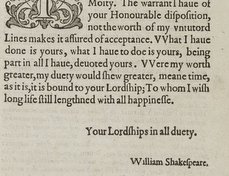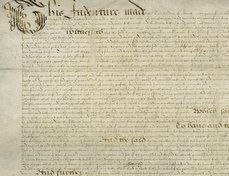Images reproduced by permission of The National Archives, London, England.
Terms of use
The National Archives give no warranty as to the accuracy, completeness or fitness for the purpose of the information provided.
Images may be used only for purposes of research, private study or education. Applications for any other use should be made to The National Archives Image Library, Kew, Richmond, Surrey TW9 4DU, Tel: 020 8392 5225 Fax: 020 8392 5266.
Document-specific information
Title: Controlment roll
Date: November 29, 1596
Repository: The National Archives, Kew, UK
Call number and opening: KB 29/234
View online bibliographic record
The enrolled entry known to Shakespeare scholars as the “Langley writ” was recorded in the Court of King’s Bench between October 29, 1596 and January 24, 1597. The writ constitutes presumptive evidence that William Shakespeare, formerly of St. Helen’s Bishopsgate, London, changed his residence to the South Bank of the Thames in Surrey (in either Bankside or the Clink) in or about 1597.
Security of peace writs were commands to keep the peace, that is to say, not to engage in violence. They occur by the hundreds as appendixes to annual rolls in the King’s Bench (Coram Rege) series. Like other entries in the King’s Bench Rolls, entries are in Latin, and are brief, giving names but little further explanation. Security of peace writs need not be taken as evidence of literal violence.
The vague details of the Langley writ itself provide little concrete evidence concerning the grounds of the dispute. The text of the entry is in abbreviated Latin:
Willelmus Wayte petit securitates pacis versus Willelmum Shakspere ffranciscum Langley
Dorotheam Soer vxorem Iohannis Soer & Annam Lee ob metum mortis &c
Attachiamentum vicecomiti Surr’ retornabile xviij Martini
[Translation:] William Wayte begs sureties of peace against William Shakspere, Francis Langley, Dorothy Soer wife of John Soer, and Anna Lee, because of fear of death, etc. [Writ of] attachment [issued and directed] to the Sheriff of Surrey, returnable on the 18th of [St] Martin [term].
William Wayte is known from contemporary documents, including an earlier writ noted below. Francis Langley was a financier and a member of St. Saviour’s parish. In the late 1580s he acquired the lordship and manor of Paris Garden, where, in 1594-5, he built the Swan playhouse. He survived until July 1602, when he was buried in St Saviour’s church. Neither Dorothy Soer, her husband John Soer, nor Anna Lee have been positively identified. But could Anne Lee be Agnes Lee, widow, resident of Moses Alley, St Saviour’s Parish, from 1597? She was buried in St Saviour’s church January 19, 1613.
Sureties of peace entries in King’s Bench rolls do not record precipitating events. Nevertheless, a writ from the preceding term, in which Francis Langley claimed sureties of peace against William Gardiner and William Wayte, may serve as a possible clue:
ffranciscus Langley petit securitates pacis versus Willelmus Gardiner & Willelmus Wayte ob metum mortis &c Attachiamentum vicecomiti Surr’ retornabile Crastino Animarum
[Translation:] Francis Langley begs sureties of peace against William Gardiner and William Wayte, because of fear of death etc. Returnable on the morrow of All Souls.
Like Langley and Wayte, William Gardiner is known from contemporary documents. As Langley and Wayte appear in both writs, the writ initiated by Wayte against Shakespeare, Langley, Soer, and Lee, looks like a tit-for-tat response in a dispute chiefly between Francis Langley and William Wayte. The dispute is more likely to have concerned the recovery of a debt than any literal threat of violence or death.
Technically the person or persons accused in a writ were to be arrested by the sheriff of the county and released on bail. It seems unlikely, however, especially given the hundreds and hundreds of contemporary writs in King’s Bench, that Wayte and Gardiner were literally arrested on Langley’s complaint, or that Shakespeare, Langley, Soer and Lee were literally arrested on Wayte’s complaint. It seems quite possible that those complained against were given verbal warnings, and perhaps required to post bail.
At the time of the Langley writ, William Shakespeare was or recently had been a householder in the parish of St. Helen’s Bishopsgate, London. He was also attached, with the rest of his playing company, to the Theater in Shoreditch. The company’s move across the River Thames to the Globe playhouse on Maid Lane, Southwark, lay some two years in the future (1599). Nevertheless, the same subsidy documents which confirm Shakespeare’s residence in St. Helen’s Bishopsgate, London, strongly suggest that he moved from there to Surrey about 1597. The Langley Writ, addressed to the Sheriff of the same county, seems to confirm the same move.
[Translation]
William Wayte begs sureties of peace against William Shakspere, Francis Langley, Dorothy Soer wife of John Soer, and Anna Lee, because of fear of death, etc. [Writ of] attachment [issued and directed] to the Sheriff of Surrey, returnable on the 18th of [St] Martin [term].
Willelmus Wayte petit securitates pacis versus Willelmum Shakspere ffranciscum Langley
Dorotheam Soer vxorem Iohannis Soer & Annam Lee ob metum mortis &c
Attachiamentum vicecomiti Surr’ retornabile xviij Martini
Written by Alan H. Nelson
Sources
Leslie Hotson, Shakespeare versus Shallow (Boston: Little, Brown, and Company, 1931), 24.
William Ingram, A London Life in the Brazen Age: Francis Langley, 1548–1602 (Cambridge, MA, Harvard University Press, 1978).
William Ingram, “Francis Langley.” in Oxford Dictionary of National Biography (ODNB), ed. H. C. G. Matthew and Brian Harrison (Oxford: Oxford University Press, 2004), http://www.oxforddnb.com/index/101068131/Francis-Langley.
Lewis, B. Roland. The Shakespeare Documents: Facsimiles, Transliterations, Translations and Commentary, vol. 1, (Stanford University, California: Stanford University Press, 1940), 217-21.
Samuel Schoenbaum, William Shakespeare: A Documentary Life (New York: Oxford University Press, 1975), 146-7.
David Thomas, Shakespeare in the Public Records (London: H.M.S.O., 1985), 6.
Last updated November 29, 2022










